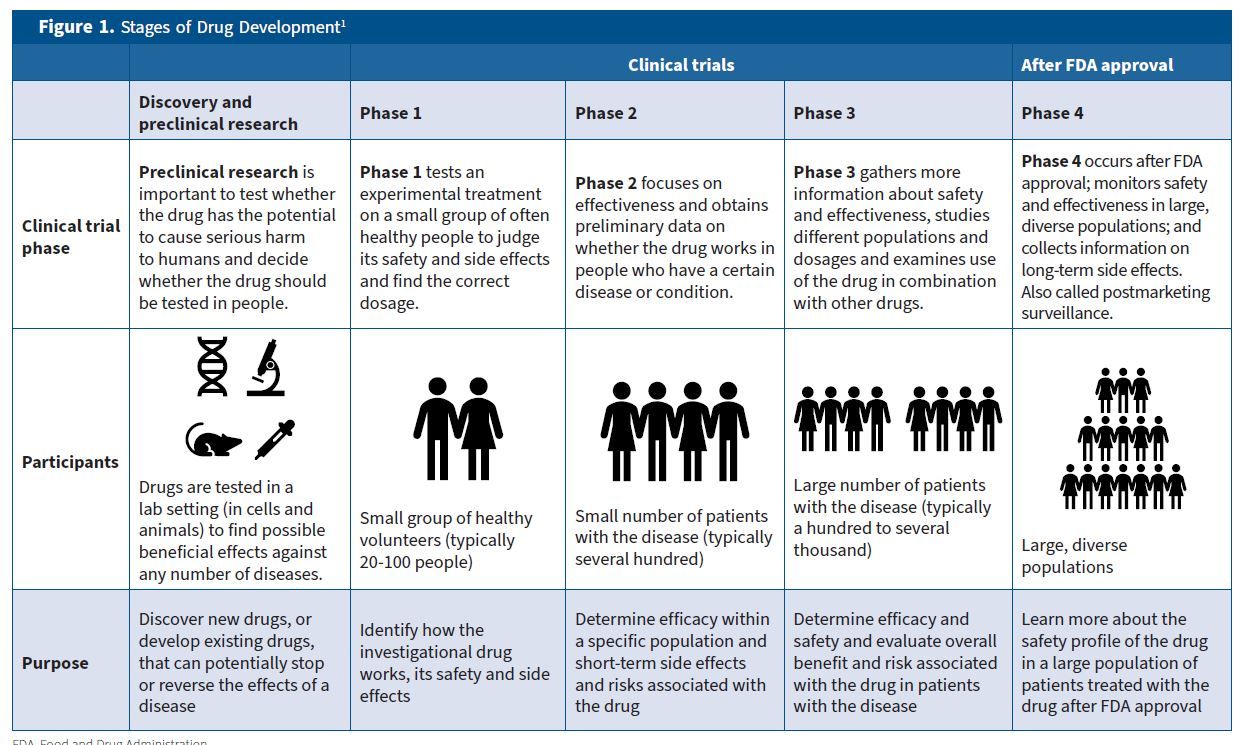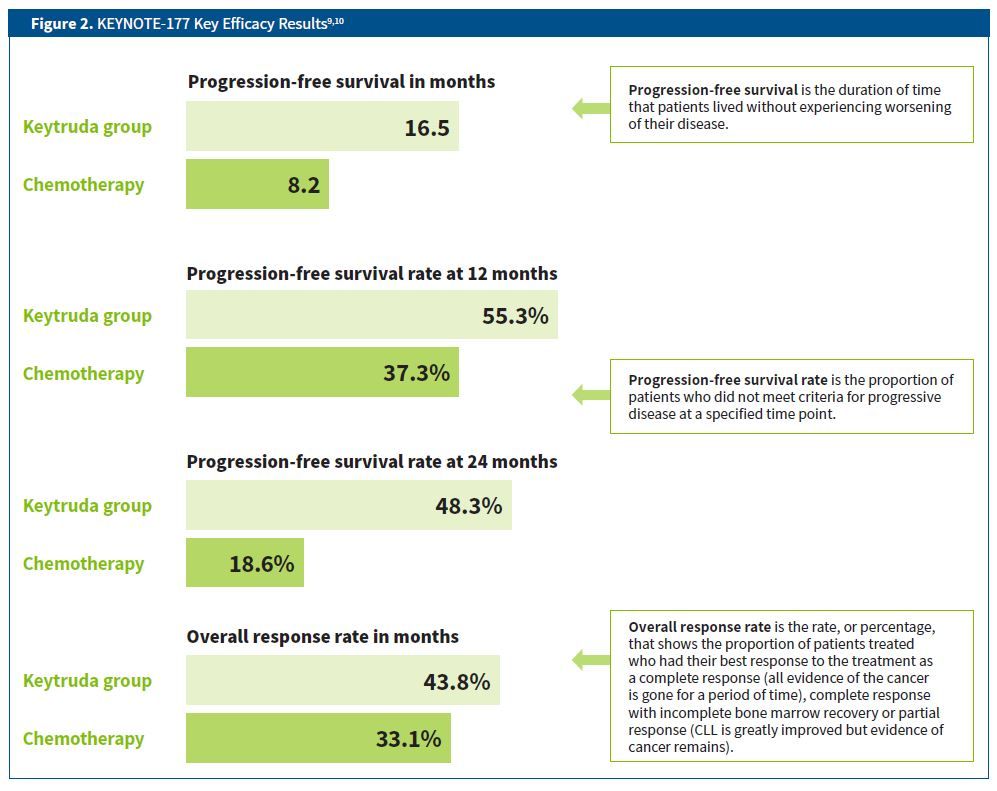Article
ASCO GI 2021: Phase 3 KEYNOTE-177 Trial
The Educated Patient®: Research Updates provides current clinical updates for different disease states. The following information is for educational purposes and is not medical advice.
FOR YOUR REFERENCE: What Are Clinical Trials?
Clinical trials determine whether a drug works in humans and if it is safe and effective. To find out whether a drug can be approved for use, the Food and Drug Administration (FDA) requires four phases of a clinical trial. The number of participants increases in each phase, starting from 20 to
80 people for a phase 1 trial to up to 3,000 for a phase 3 trial (Figure 1).1
- Phase 1: tests an experimental treatment on a small group of
often healthy people to judge its safety and side effects and find the correct dosage. - Phase 2: focuses on effectiveness and obtains preliminary data
on whether the drug works in people who have a certain disease
or condition. - Phase 3: gathers more information about safety and effectiveness, studies different populations and dosages and examines use of the drug in combination with other drugs.
- Phase 4: occurs after FDA approval; monitors safety and effectiveness in large, diverse populations; and collects information on long-term side effects.

FOR YOUR REFERENCE: What Is Metastatic Colorectal Cancer?
Colorectal cancer starts in the colon or rectum and is often called colon cancer or rectal cancer depending on where it starts. Metastatic colon cancer (also known as advanced colon cancer or stage 4 colon cancer) is cancer that has spread beyond the colon to other organs. Colon cancer usually spreads to the liver because the blood supply from the colon is connected to the liver by a large blood vessel. However, it can also spread to the lining of the abdomen (peritoneum), ovaries, brain or other organs.2,3
Surgeons can remove colon and liver tumors during the same procedure to reduce pain and shorten recovery time. In some cases, it is necessary for the surgeon to perform a colostomy. The surgeon cuts the colon above the cancer and attaches the end to an opening in the belly. Waste is collected from the opening into a bag attached to the skin.4
Additional treatment options for patients with metastatic colon cancer include the following3,4:
- Chemotherapy before and after surgery.
- Targeted therapies, which attack specific genes and proteins in cancer cells.
- Immunotherapy, which uses the body’s immune system to attack cancer cells and is an option for people with colon cancer whose cancer cells have a specific genetic makeup.
- Interventional radiology treatments, such as ablation, which use highly focused energy to shrink or destroy tumors before or after surgery. They are often combined with embolization, which involves injecting tiny particles to block or reduce blood flow to cancer cells.
FOR YOUR REFERENCE: What Medications Were Investigated in the KEYNOTE-177 Trial?
Keytruda (pembrolizumab) is a type of immunotherapy called a monoclonal antibody. It is designed to prevent cancer cells from multiplying and spreading inside the body.5
To understand how Keytruda works, it helps to first learn about two cell proteins called programmed death 1 (PD-1) and programmed death-ligand 1 (PD-L1). PD-1 is found on the body’s T cells, a type of immune cell that normally attacks and kills invaders such as cancer cells. PD-L1 is found on cancer cells as well as other types of cells. If PD-1 and PD-L1 bond together, this interaction stops T cells from killing cancer cells and allows the cancer to spread. Keytruda prevents PD-1 and PD-L1 from bonding, freeing T cells to continue killing cancer cells.6
Zirabev (bevacizumab), a vascular endothelial growth factor inhibitor, lowers the amount of microvascular growth of tumor blood vessels.7 The monoclonal antibody Erbitux (cetuximab) blocks epidermal growth factor receptors on cancer cells, reducing growth and division.8 Chemotherapy regimens included in the study were modified FOLFOX6 (leucovorin, fluorouracil and oxaliplatin) and FOLFIRI (leucovorin, fluorouracil and irinotecan).
ASCO GI 2021: Phase 3 KEYNOTE-177 Trial
The KEYNOTE-177 study is a phase 3 trial composed of patients with microsatellite instability-high/mismatch repair-deficient metastatic colorectal cancer (MSI-H/dMMR mCRC). Taking place at 192 cancer centers in 23 countries, the study examined how well Keytruda performed in these patients as a first-line therapy versus standard-of-care chemotherapy plus Zirabev or Erbitux.9
Patients (N = 307) were randomly chosen to receive either Keytruda or chemotherapy. In the Keytruda group, patients received the medication once every three weeks for up to two years. Chemotherapy drugs were given to patients in the other group every two weeks, either with or without Zirabev or Erbitux.9 Imaging was performed on tumors every nine weeks.10
Patients in the chemotherapy group who experienced disease progression were permitted to transfer into the Keytruda group. Treatment was continued until patients experienced disease progression, withdrew because of toxicity of side effects or at investigators’ discretion, or until completion of 35 cycles in the Keytruda group.9 Progression-free survival (PFS) and overall survival (OS) were the study’s primary end points, with overall response rate (ORR) and safety measures as the secondary end points.9
Results
At the time of the data cutoff, the Keytruda group had a median follow-up duration of 28.4 months compared with 27.2 months in the chemotherapy group. PFS was higher in the Keytruda group
(16.5 months) compared with the chemotherapy group (8.2 months; Figure 2).9,10 At 12 months and 24 months, PFS rates in the Keytruda group were 55.3% and 48.3%, respectively, compared with 37.3% and 18.6% in the chemotherapy group.9

The ORR in the Keytruda group was 43.8% compared with 33.1% in the chemotherapy group. The OS rate had not yet been determined and will be included in the final analysis.9 Patients in the Keytruda group achieved higher quality of life scores than those in the chemotherapy group, and median time until patients experienced deterioration of physical functioning, social functioning and fatigue scores was longer in the Keytruda group.11 The median duration of response had not yet been reached in the Keytruda group, whereas in the chemotherapy group it was 10.6 months.9
Grade 3 (severe) or higher side effects related to treatment were far more common in the chemotherapy group than in the Keytruda group (66% versus 22%, respectively; Figure 3). The Keytruda group experienced no grade 5 (causing death) side effects, whereas one patient in the chemotherapy group experienced a fatal intestinal perforation related to treatment.12

Given the extended PFS, greater ORR, higher quality of life scores and significantly fewer severe side effects in patients taking Keytruda, the study’s investigators think that Keytruda and not chemotherapy should be the new standard of care for patients with MSI-H/dMMR mCRC.9
Not all patients qualify for certain clinical trials. If you are interested in enrolling in a trial, talk with your doctor about which treatment options would be most appropriate for you.
Not all patients qualify for certain clinical trials. If you are interested in enrolling in a trial, talk with your doctor about which treatment options would be most appropriate for you.
FOR YOUR REFERENCE: Glossary of Terms
Abdomen: the area of the body that contains the pancreas, stomach, intestines, liver, gallbladder and other organs
Ablation: a technique for eliminating tumors without surgery; can be done with minimally invasive techniques on an outpatient basis
ASCO GI: American Society of Clinical Oncology Gastrointestinal Cancers Symposium
Blood vessel: a tube through which the blood circulates in the body. Blood vessels include a network of arteries, arterioles, capillaries, venules and veins.
Chemotherapy: treatment that uses drugs to stop the growth of cancer cells either by killing the cells or by stopping them from dividing. These drugs are taken by mouth or injected and enter the bloodstream so they can help fight cancers that spread throughout the body. This can affect cancer cells and normal cells.
Colon: the longest part of the large intestine
Colostomy: an opening into the colon from the outside of the body. A colostomy provides a new path for waste material to leave the body after part of the colon has been removed.
End point: in clinical trials, an event or outcome that can be measured objectively to determine whether the intervention being studied is beneficial
Epidermal growth factor receptor (EGFR) inhibitor: a substance that blocks the activity of a protein called EGFR, which is involved in cell growth and division, such as that of some types of cancer cells
First-line therapy: the first treatment given for a disease
Immunotherapy: type of therapy that uses substances to stimulate or suppress the immune system to help the body fight cancer, infection and other diseases. Some types of immunotherapy only target certain cells of the immune system; others affect the immune system in a general way.
Liver: a large organ located in the upper abdomen, near the stomach, intestines, gallbladder and pancreas. The liver cleanses the blood and aids in digestion by secreting bile.
Microsatellite instability-high/mismatch repair deficient: cancer cells that have a high number of mutations (changes) within short, repeated sequences of DNA
Microvascular: involving the smallest blood vessels
Monoclonal antibody: a type of protein made in the laboratory that can identify substances in the body, including cancer cells. Monoclonal antibodies can be used alone or to carry drugs, toxins or radioactive substances directly to cancer cells.
Ovaries: one of a pair of female glands in which the eggs form and the female hormones estrogen and progesterone are made
Overall response rate: the percentage of people in a study or treatment group who have a partial or complete response to the treatment within a certain period of time
Overall survival: the length of time from either the date of diagnosis or the start of treatment for a disease that a patient is still alive
Programmed death 1: a protein on the surface of T cells that helps keep the body’s immune responses in check
Programmed death-ligand 1: a protein found on some types of cancer cells
Progression-free survival: the length of time during and after the treatment of a disease that a patient lives with the disease but it does not get worse
Progression-free survival rate: the proportion of patients who did not meet criteria for progressive disease at a specified time point
Peritoneum: the tissue that lines the abdominal wall and covers most of the organs in the abdomen
Quality of life: the patient’s overall enjoyment of life. Many clinical trials assess the effects of cancer and its treatment on quality of life. These studies measure aspects of an individual’s sense of well-being and ability to carry out activities of daily living.
Rectum: the final six inches of the digestive system
Side effect: any unfavorable or unintended disease, sign or symptom that occurs during the time a patient is receiving a medical treatment or procedure
Standard of care: treatment that is accepted by medical experts as a proper treatment for a certain type of disease
Targeted therapy: a cancer treatment that uses drugs to target specific aspects of the cancer cells
Toxicity: the extent to which something is poisonous or harmful
Tumor: an abnormal mass of tissue that forms when cells grow and divide more than they should or do not die when they should
Vascular endothelial growth factor inhibitor: blocks a substance made by cancer cells that stimulates new blood vessel formation and helps the cancer grow
References
- What are clinical trials and studies? National Institute on Aging. Accessed March 15, 2021. https://www.nia.nih.gov/health/what-are-clinical-trials-and-studies
- About colorectal cancer. American Cancer Society. Updated June 29, 2020. Accessed May 14, 2021. https://www.cancer.org/cancer/colon-rectal-cancer/about/what-is-colorectal-cancer.html
- Treatment for metastatic colon cancer. Memorial Sloan Kettering Cancer Center. Accessed May 14, 2021. https://www.mskcc.org/cancer-care/types/colon/treatment/metastases
- Treatment of colorectal cancer, by stage. American Cancer Society. Updated June 29, 2020. Accessed May 14, 2021. https://www.cancer.org/cancer/colon-rectal-cancer/treating/by-stage-colon.html
- How does Keytruda work? Merck Oncology. Accessed May 1, 2021. https://www.keytruda.com/how-does-keytruda-work
- Prasad V, Kaestner V. Nivolumab and pembrolizumab: monoclonal antibodies against programmed cell death-1 (PD-1) that are interchangeable. Semin Oncol. 2017;44(2):132-135. doi:10.1053/j.seminoncol.2017.06.007
- Kazazi-Hyseni F, Beijnen JH, Schellens JHM. Bevacizumab. Oncologist. 2010;15(8):819-825. doi:10.1634/theoncologist.2009-0317
- Cetuximab. Vanderbilt University Marnett Research Laboratory. Accessed May 5, 2021. https://www. lab.vanderbilt.edu/marnett-lab/cetuximab/
- Andre T, Shiu KK, Kim TW, et al. Pembrolizumab versus chemotherapy for microsatellite instability-high/mismatch repair deficient metastatic colorectal cancer: the phase 3 KEYNOTE-177 Study. J Clin Oncol. 2020;38(18):LBA4. doi:10.1200/JCO.2020.38.18_suppl.LBA4
- Keytruda. European Medicines Agency. Accessed May 7, 2021. https://www.ema.europa.eu/en/documents/variation-report/keytruda-h-c-3820-ii-0091-epar-assessment-report-variation_en.pdf
- Andre T, Amonkar M, Norquist JM, et al. Health-related quality of life in patients with microsatellite instability-high or mismatch repair deficient metastatic colorectal cancer treated with first-line pembrolizumab versus chemotherapy (KEYNOTE-177): an open-label, randomised, phase 3 trial. Lancet Oncol. 2021;22(5):665-677. doi:10.1016/S1470-2045(21)00064-4
- Andre T, Shiu KK, Won Kim T, et al. KEYNOTE-177: phase III randomized study of pembrolizumab versus chemotherapy for microsatellite instability-high advanced colorectal cancer. J Clin Oncol. 2021;39(suppl 3):6. doi:10.1200/JCO.2021.39.3_suppl.6



